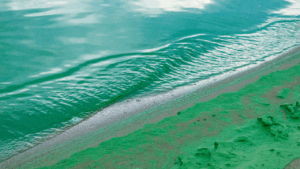by Paige Jessup, Climate Change Resiliency Intern
Despite its name, blue-green algae is not actually algae – it is a type of bacteria called cyanobacteria that lives in fresh and marine water. Most species of cyanobacteria are unicellular and photosynthetic, meaning they use sunlight to produce their own food. Blue-green algae can reproduce rapidly in warm, slow-moving, nutrient rich environments. In the right conditions, these bacteria will rapidly reproduce and cause a bloom, spreading across a water’s surface and concentrating into surface scums (Pick, 2016).
Impacts of Cyanobacteria
Blooms of cyanobacteria can be potentially dangerous, with many species containing cyanotoxins that get released into the water when the cells die or rupture (Government of Canada, 2024). These toxins include neurotoxins that affect the central nervous system, hepatotoxins that affect liver function, and dermatotoxicity which affects the skin. The ones most at risk of coming into contact with these toxins are swimmers and other water recreationists, pets, and livestock. There is also potential for these toxins to leach into drinking water supplies.
The dangers of cyanotoxins do not only apply to people; severe blooms in lakes have ultimately led to oxygen depletion in the water, resulting in massive fish and plant die-offs (Cheung et al., 2013). Cyanobacteria are also consumed by aquatic organisms, including zooplankton, aquatic insects, and fish, which in turn are consumed by larger aquatic animals and birds. The effects of consuming cyanotoxins on aquatic and terrestrial wildlife range from acute to chronic, sometimes resulting in death in high concentrations (Zanchett et al., 2013).

Reducing our Impact
Numerous case studies have demonstrated that reduced nutrient loading corresponds to declining cyanobacterial biomass in lakes (Pick, 2016). Therefore, by reducing the amount of nutrients we use on-land that will eventually end up in our freshwater ecosystems, we are protecting them from these harmful algal blooms. This means avoiding products containing phosphorus, and using best practice for waste water treatment. Nutrients can also enter the water through run-off. One of the best ways to mitigate run-off is by keeping our shorelines natural. The roots of plants bind to the soil and prevent erosion and absorb excess nutrients before they can enter the water.
Monitoring and Safety
Monitoring and reporting is also critical to maintain public safety when it comes to potentially harmful algae blooms. Monitoring can happen on different levels but it largely relies on the public to report any possibly new blooms that they see. Reporting will vary throughout the country but if you want to report a potentially harmful algae bloom, look into whatever authority is responsible for the watershed in your area. If you believe you have spotted one of these blooms, avoid using, drinking, swimming, or bathing in the water, and restrict pet and livestock access to the water.
Remember in regards to toxic cyanobacteria, even if the algae looks like it is gone, cyanotoxins are released when the bacteria die-off. Right after the bloom dies off is the most dangerous times to be in the water. It is best to wait until your local watershed authority says it is safe to be in the water again. Public safety and water quality is everyone’s responsibility, so let us all make sure to do our part to keep Canada’s beautiful freshwater ecosystems safe.
This blog is part of a larger education toolkit about cyanobacteria. To access all of the resources from the toolkit, visit watersheds.ca/cyanobacteria
References
Cheung, M. Y., Liang, S., & Lee, J. (2013). Toxin-producing cyanobacteria in freshwater: A review of the problems, impact on drinking water safety, and efforts for protecting public health. The Journal of Microbiology, 51(1), 1-10. doi:10.1007/s12275-013-2549-3
Government of Canada. (2024, June 13). Recreational water and health: Cyanobacteria and their toxins. Retrieved from https://www.canada.ca/en/health-canada/services/environment/recreational-water/cyanobacteria-toxins.html
Pick, F. R. (2016). Blooming algae: a Canadian perspective on the rise of toxic cyanobacteria. Canadian Journal of Fisheries and Aquatic Sciences. 73(7): 1149-1158. doi:10.1139/cjfas-2015-0470
Zanchett, G., & Oliveira-Filho, E. C. (2013). Cyanobacteria and cyanotoxins: from impacts on aquatic ecosystems and human health to anticarcinogenic effects. Toxins, 5(10), 1896–1917. doi:10.3390/toxins5101896
This piece is part of an education toolkit generously funded by:


Do traditional lake water treatment systems make water safe for drinking in cases of cyanobacteria?